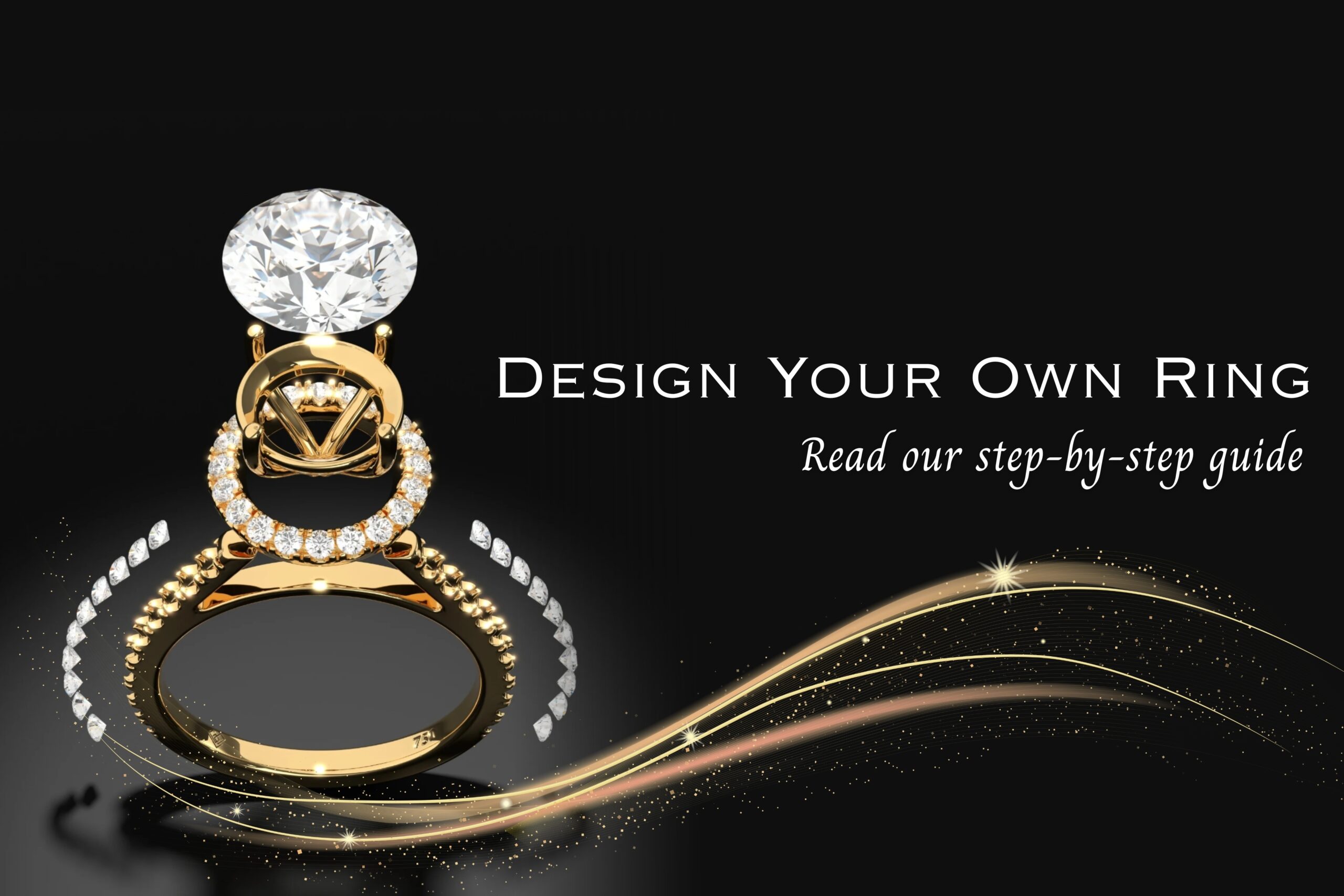Bespoke Diamond Engagement Rings: Build Ring Step-by-Step
Planning a proposal is personal, but designing an engagement ring is something many couples choose to do together. A bespoke ring allows you to create a piece that reflects your partner’s style and your shared story, and she will wear it for the rest of her life and show it to everyone she knows. So it has to be special and not something that is not even her type.
Many people have an idea of the style they prefer, and she already has an ideal ring type in her mind. You have to take some time and create a realistic budget to make it come true, because good things take time, proper planning, and some smart money to use wisely. So, if you are planning an engagement ring, consider using this guide, which covers the major sections of what to look for when buying bespoke diamond engagement rings online, and create something that lasts forever.
What “Bespoke” Really Means
Bespoke means something that is made exclusively for you, tailored to your specifications, and not everyone has a specific custom design. From the CAD to certification of the final product, you will have manufacturing control by collaborating with your jeweler. It is private, made to order, and customized just for you, depending on your diamond preference, your tone, your size, and each detail you want is under your control. Bespoke jewelry is something you make from scratch, by selecting every character of the ring yourself.
However, bespoke doesn’t always have to be the most iconic or the most unique that no one can ever make; it can also be already available on the market, but you want to recreate it in your own style. By adding details, making changes, and playing with the settings, with your final approval, you can make it bespoke to you, not to others. You don’t need approval from others about it not being bespoke, as it already exists. Bespoke diamond engagement rings are something made to represent your love life and your future.
Complete Guide: Build Bespoke Diamond Engagement Rings Step-by-Step
Now that you know what bespoke means and how it adds value to an engagement ring, let’s start with a step-by-step guide. In each section, structurally, we’ll start from the bottom by choosing the center stone and determining which setting will complement it best.
After that, we’ll go through the other aspects of the ring, such as diamond carat size, band type and width, prong types, and metal tones that affect the overall look. We’ll also discuss what to look for or avoid, as well as what questions to ask your jeweler for the best results. Let’s dig in.
Center Stone: How Each Shape Looks with Different Styles and Settings
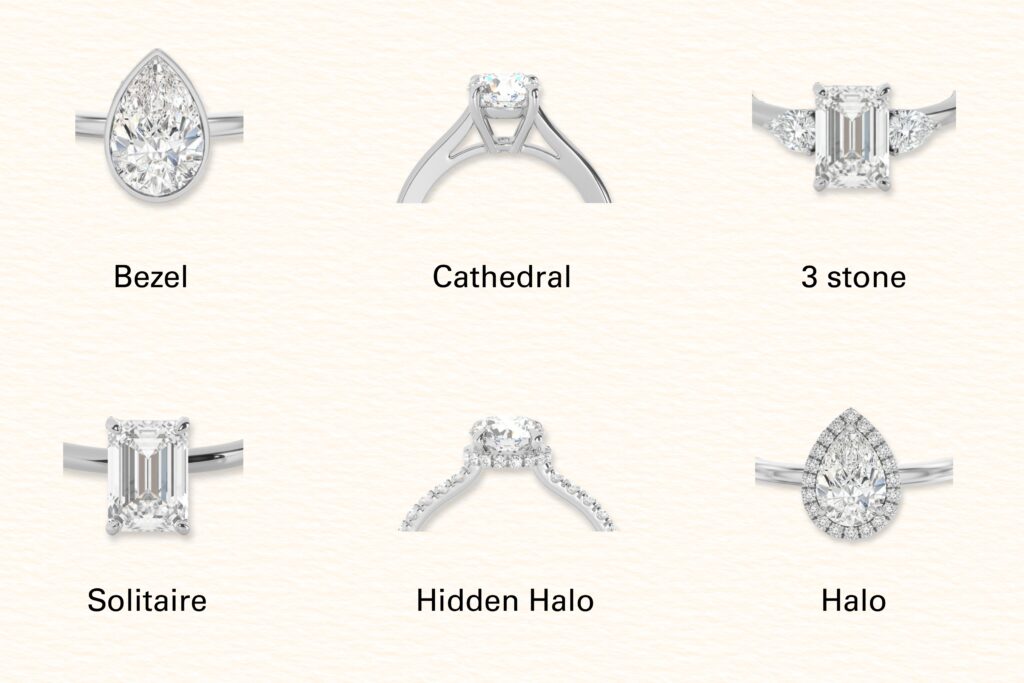
Choosing a center stone and its setting is like getting the head of an engagement ring. The center diamond is the star of the show, and the setting style is its director. Your setting will either make or break the look of your engagement ring.
There are plenty of options available for your center stone, ranging from common cuts like round to oval, and custom cuts like shield to kite, as well as antique cuts like OEC and OMC. So, first, clear your goal and choose a diamond that suits your style, has meaning, or one that you think looks good and sparkling.
1. Round Cut – The Brilliance Standard
| Setting Style | Suitability Score Criteria: Security, Visual symmetry, Popularity data, and Practicality. | Notes |
| Solitaire (Plain/Pavé) | 10/10 | The undisputed favorite. Timeless, maximizes light return, and always “in style.” |
| Hidden Halo | 9/10 | Very popular modern choice. Adds sparkle from the side without changing the classic face-up look. |
| Cathedral | 8/10 | It gives a great height and an elegant profile, works best with a round cut. |
| Three-Stone | 7/10 | Classic, meaningful look. Tapered sides are preferred over round sides for balance. |
| Halo | 6/10 | Historically popular for maximizing size, complementing a small carat-size center diamond. |
| Bezel | 6/10 | Chosen for security and modern/minimal aesthetics, but some feel it hides too much sparkle; it also depends on craftsmanship. |
2. Oval Cut – The Elongating Trend
| Setting Style | Suitability Score Criteria: Security, Visual symmetry, Popularity data, and Practicality. | Notes |
| Solitaire (Thin Band) | 10/10 | The default choice. It highlights the slimming effect and large surface area of the oval. |
| Hidden Halo | 9/10 | Extremely popular to add a touch of “secret sparkle” and lift the stone slightly. |
| Bezel | 7/10 | Gaining traction for its modern, smooth look and protecting the potentially weak tips and hide bow effect well. |
| Three-Stone | 8/10 | Elegant choice; side stones must be perfectly proportioned to avoid overpowering the oval. Small pears or trillion-cut diamonds will look better together. |
| Halo | 7/10 | It can make the ring look a bit large and lose the desirable elongation effect; it’s up to personal preference. |
| Cathedral | 6/10 | It can look beautiful, perfect for people who want extra height, so the diamond can be seen clearly. |
| Vintage Milgrain | 5/10 | A romantic niche pick, generally favored only for a specific antique aesthetic. |
3. Emerald Cut – The Step-Cut Sophisticate
| Setting Style | Suitability Score Criteria: Security, Visual symmetry, Popularity data, and Practicality. | Notes |
| Solitaire (Straight Prongs) | 10/10 | The ultimate choice. Its simplicity allows the unique “hall of mirrors” effect to shine without distraction. |
| Three-Stone | 9/10 | Quintessential expensive-looking, timeless setting. The side stones perfectly complement the geometry. |
| Bezel | 8/10 | Hugely popular for Art Deco, “quiet luxury” vibes, and protecting the sharp corners. |
| Vintage Milgrain | 7/10 | Give a vintage aesthetic look, best for people who prefer Art Deco style. |
| Hidden Halo | 6/10 | Provides a discreet boost of brilliance without disrupting the clean lines of the top. |
| Cathedral | 6/10 | Good for height, but sometimes itdistracts from the horizontal elegance of the cut. |
| Halo | 5/10 | Generally considered a poor match as the brilliant-cut halo clashes with the step-cut clarity. Again, it’s up to personal preferences. |
4. Cushion Cut – The Soft & Sparkly
| Setting Style | Suitability Score Criteria: Security, Visual symmetry, Popularity data, and Practicality. | Notes |
| Solitaire | 9/10 | High score for its enduring, romantic appeal that emphasizes the soft, rounded corners. |
| Halo | 8/10 | Very common pairing. The cushion’s shape suits the halo well, making the ring appear significantly larger. |
| Hidden Halo | 8/10 | A preferred choice for those who want extra sparkle without the full Halo commitment, creating a truly beautiful ring effect. |
| Vintage Milgrain | 7/10 | An excellent match, as the cushion is an “Old Mine Cut” revival, perfectly suited to antique touches. |
| Three-Stone | 7/10 | A sophisticated look; half-moon side stones are the most flattering for their shape. |
| Cathedral | 6/10 | Adds a beautiful, elegant height to the pillow shape. |
| Bezel | 5/10 | Offers security but can slightly reduce the visible surface area of an already deep cut. |
5. Pear Cut – The Tear Drop
| Setting Style | Suitability Score Criteria: Security, Visual symmetry, Popularity data, and Practicality. | Notes |
| Solitaire | 9/10 | The standard choice. The essential V-prong protects the point, showcasing the unique shape; the other prongs also work well, though. |
| Halo | 8/10 | A very popular pairing that balances the shape, boosts size, and secures the entire perimeter. |
| Hidden Halo | 8/10 | A clean, modern way to add protection and a lift of light. |
| Bezel | 8/10 | Highly praised for the maximum protection it offers to the vulnerable pointed end. |
| Three-Stone | 7/10 | A striking look, but avoid placing the diamond vertically or getting uneven shapes; choose one-sided pointed diamonds, like a small pear cut or a tapered baguette with an east-west setting. |
| Cathedral | 6/10 | Adds a noticeable height to the asymmetrical shape, the design stacks flush with your wedding band for a clean finish. |
| Double Halo | 3/10 | It boasts a very high “bling factor,” but is often viewed as over-the-top, overshadowing the stone’s elegance. |
6. Radiant Cut – The Elongated Sparkler
| Setting Style | Suitability Score Criteria: Security, Visual symmetry, Popularity data, and Practicality. | Notes |
| Solitaire | 10/10 | Maximizes light return and emphasizes the brilliant sparkle. Simple is often best for this cut. |
| Hidden Halo | 9/10 | The ideal complement. It boosts the radiant’s intense sparkle without cluttering the face-up view. |
| Three-Stone | 8/10 | One of the best three-stone cuts. The geometric side stones perfectly mirror the main stone’s structure and create the illusion of a perfect diamond. |
| Halo | 7/10 | A great option for maximum bling, as the radiant’s sparkle is intensified by the halo. |
| Bezel or half bezel | 7/10 | Works well for a sleek, contemporary, and highly secure look. |
| Cathedral | 5/10 | Elegant, but be mindful of the resulting height, as radiants are often deeper stones. |
| Vintage Milgrain | 4/10 | Less common, as the radiant is a modern cut, but it can offer a unique softness. |
7. Princess Cut – The Square Brilliant
| Setting Style | Suitability Score Criteria: Security, Visual symmetry, Popularity data, and Practicality. | Notes |
| Solitaire (V-Prongs) | 9/10 | Essential. The V-prongs provide the necessary protection for the fragile corners while maintaining a clean look. |
| Hidden Halo | 8/10 | Adds sparkle and helps prevent snagging by slightly covering the tips. |
| Bezel | 8/10 | Highest score for protection. Encasing the stone is the best way to prevent chipping on the corners. |
| Cathedral | 7/10 | Complements the angular shape, giving it a regal, taller look. |
| Halo | 6/10 | A popular way to maximize size, create a large, square display of sparkle. |
| Three-Stone | 5/10 | Classic, but must be set carefully to maintain sharp and balanced lines. |
| Floating Head | 3/10 | Highly risky for this cut, as its sharp corners require secure metal coverage. |
8. Asscher Cut – The Art Deco Master
| Setting Style | Suitability Score Criteria: Security, Visual symmetry, Popularity data, and Practicality. | Notes |
| Bezel | 10/10 | The absolute Art Deco classic. The bezel frame perfectly emphasizes the strong geometric lines and protects the corners. |
| Vintage Milgrain | 10/10 | The perfect engagement ring pairing. The milgrain detailing is quintessential Art Deco, the era for which the Asscher was designed. |
| Solitaire | 9/10 | A clean, minimalist look that lets the step-cut clarity shine without any distractions. |
| Three-Stone | 8/10 | Timeless, sophisticated, and highly praised for its ability to complement the cut’s geometry. |
| Hidden Halo | 6/10 | Adds a touch of modern brilliance while preserving the cut’s historical charm. |
| Halo | 4/10 | The brilliant-cut halo can detract from the unique, clean flashes of the step-cut. |
| Floating Head | 2/10 | Too modern for the vintage aesthetic, and it poses a significant risk. |
9. Heart Cut – The Sentimental Choice
| Setting Style | Suitability Score Criteria: Security, Visual symmetry, Popularity data, and Practicality. | Notes |
| Solitaire | 8/10 | The required prongs clearly define the shape, which is the primary goal of this cut. |
| Bezel | 7/10 | Highly praised on Reddit for taking a potentially “juvenile” shape and making it look sleek, modern, and very secure. |
| Halo | 6/10 | Popular for making the heart shape look larger and giving it a defined, bold outline. |
| Hidden Halo | 6/10 | A good compromise to define the shape and add sparkle without excessive bling. |
| Three-Stone | 5/10 | It can be difficult to balance; side stones must be very small to avoid cluttering the unique shape. |
| Vintage Milgrain | 4/10 | Adds a nice, romantic texture, but not a primary choice for this cut. |
| Floating Head | 2/10 | It is challenging to create a secure setting that accurately defines the heart shape. |
Choose the Center Diamond carat size based on lifestyle + finger

When considering carat weight, keep in mind that different diamond shapes carry weight differently. For example, a 2.5-carat pear-cut diamond will always appear larger when compared to a 2.5-carat emerald-cut diamond, depending on its depth and length-to-width ratio. An oval-cut diamond will look larger than a round-cut cut because it has a larger table. But sometimes the table percentage varies widely. The table is the largest facet seen when the diamond is viewed face up. Not only shape, but also cut geometry, face-up area, spread, and depth of a diamond can change its appearance in carat size.
So, just don’t look only at carat size or try to choose the largest numbers out there, because later, when your design is finished with the side setting, your ring will look bulky for sure. Unless you want an extraordinarily big ring. Because the carat size you choose will affect your budget widely.
Always ask to see a real image of the stone on a person’s finger so you can gauge if it is the ideal carat size and will complement your finger width.
The list below shows the average carat size of diamonds for bespoke diamond engagement rings that people choose most often, depending on their style and preferences.
- 0.75 ct
- 1.00 ct
- 1.25 ct
- 1.50 ct
- 2.00 ct
- 3.00 ct
Band Types & Widths: How They Change the Look of a Ring
The band of your engagement ring is the foundation of your entire design. Even if you have a gorgeous center stone, if the band is not good enough to complement the style of your ring’s head, it can quietly downgrade the overall look. When selecting a band, there are two key factors to consider: band type and band width.
Band Types
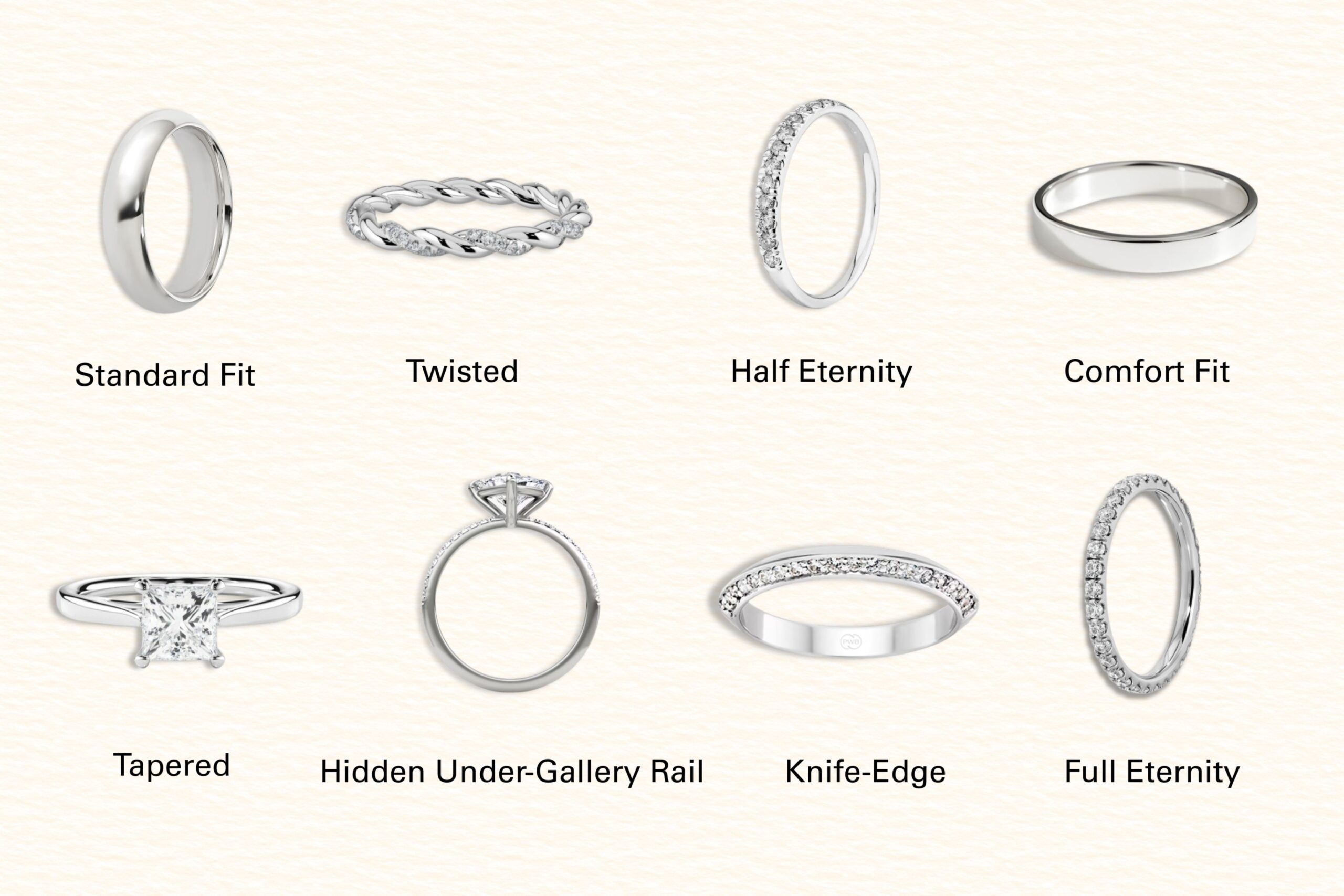
First, let’s talk about band type. There are numerous options available, so it’s very common to get confused; however, the fun part is that you can customize as much as you want. Every type mentioned here can be customized individually for your bespoke diamond engagement rings.
- Knife-Edge
A sharp edge that creates the illusion of a slimmer band. Great for individuals who want their diamond to appear larger without adding bulk. This band can be customized in various ways, such as setting the diamonds if your center stone is a little plain, or engraving the band as desired. Options are unlimited, but the choice is yours. - Standard Fit Plain Gold/Platinum
You will see no curve in this band; it is a simple, straight-cut band that offers a flat surface on the inner side. This band style offers a little flexibility for sizing, and it works best for detailed designs, as it has more flat surfaces than others. - Comfort Fit
For the ring she’s gonna wear through everyday wear and tear, this band style is best. Rounded inside edges give a soft, smooth feel. Best for individuals who wear rings 24/7 and prefer the most practical, everyday option. This comfort-fit band is also ideal for men. - Half Eternity Micro Pave
Tiny diamonds are set closely together, but the diamonds are set halfway around, which means only the front side of the ring will have diamonds encrusted on the band. This band offers a Good balance of sparkle and comfort, with resizing flexibility. Offers maximum sparkle with a delicate, feminine look. - Full Eternity Micro Pave
This band features diamonds throughout. This looks super luxurious and sparkling, but it cannot be resized easily. This ring will require more maintenance than others and crave extra sparkle. However, it will be worth it all, as this will surely make a lasting impression at first. - Twisted Band
This band features a twisted shank, with two strands intertwined or braided together, and is gracefully curved, floating around the ring finger in a continuous flow. A twisted band is a meaningful piece that connects the story, representing two paths becoming one, making it ideal for both an engagement ring and a wedding band. - Tapered Band
This band shows a minor difference, but it still affects how your center diamond appears. This style gently narrows as it approaches the center stone, making the diamond appear larger. One of the most flattering choices for all shapes. - Hidden Under-Gallery Rail
You have heard of a hidden halo; it’s an invisible gallery rail where just diamonds are added to it. It is the best band setting to increase your ring’s durability. This essentially acts as a seatbelt going around the prongs of your ring, making them harder to snag and pull down. It also acts as a bumper shield for the girdle of your stone. The girdle is this thin border around the widest part of the diamond, and it is the most prone to chipping because it is so thin. So getting this setting will surely help.
Band Width
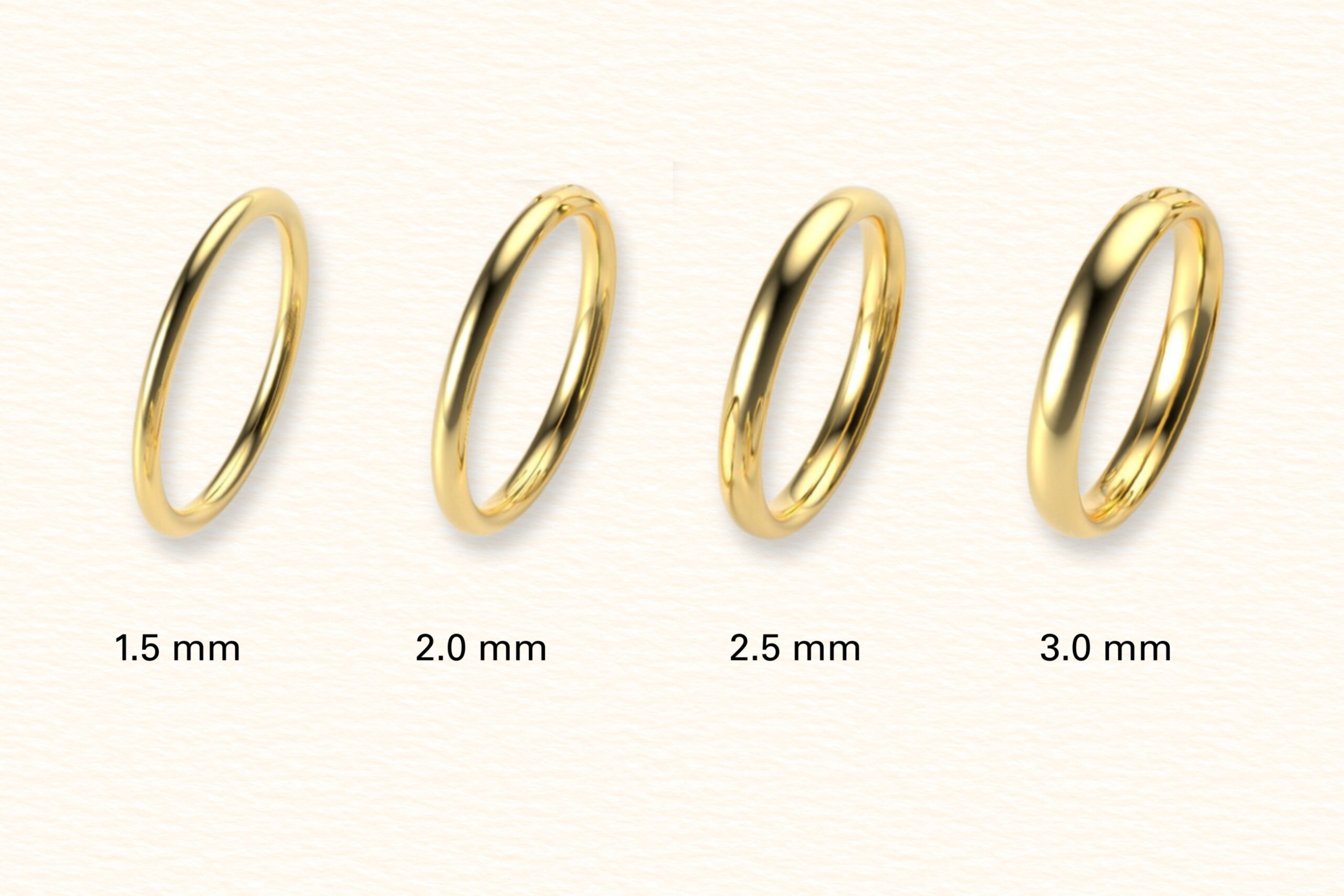
Choose band width wisely according to your diamond carat size. If you choose a band with more width, your diamond will appear small, and if you select a too-thin, narrow band, it can crack and may not work well with a large diamond or a large setting. Here are the ideal band sizes to choose, which will work with almost all settings and diamond sizes.
- 1.5mm band
- 2.0mm band
- 2.5mm band
- 3mm band
Prong Styles: Small Detail, Big Impact
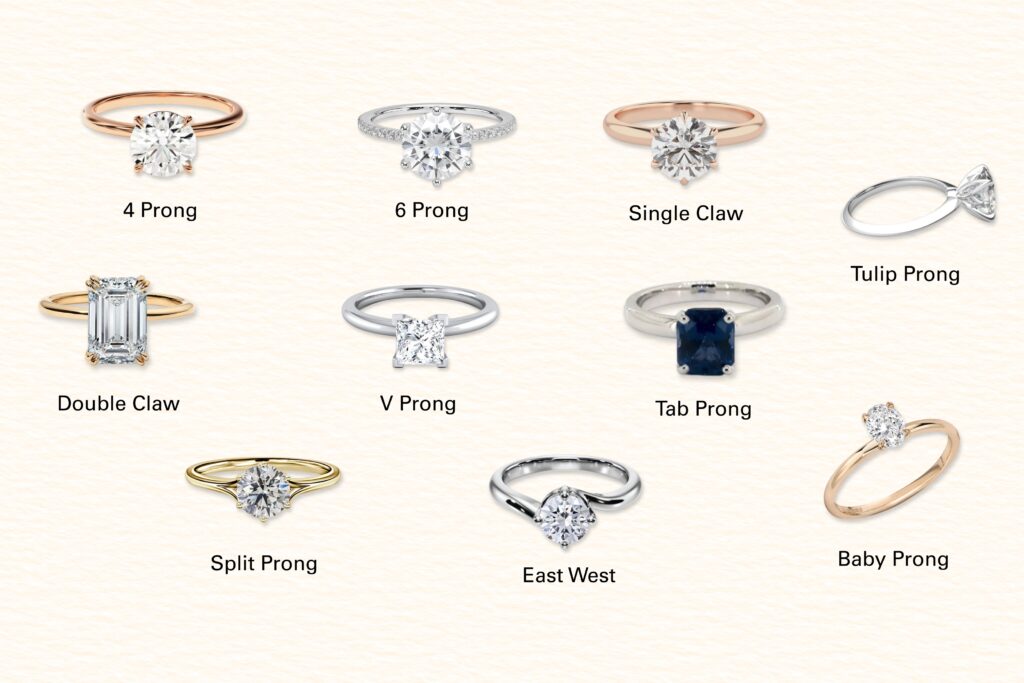
The prong plays the most important role in protecting your diamond. It is the small strips of metal that create a cone-like basket, holding the center diamond securely in place. If you are using the wrong prong with the wrong diamond and setting, you risk losing or chipping your diamond. Choose from these prongs, mostly used in engagement rings.
- 4 prong
- 6 prong
- double claw
- single claw
- baby claw
- split prong
- V-prong
- tab prong
- tulip prong
Metal Choice Comparison – How Each Metal Changes the Look

One of the most common things people often overlook when buying an engagement ring is the metal tone. Different gold tones will give different effects on different skin undertones. Even with the same design, the metal color can appear different on two individuals due to their unique skin undertones.
If you have a warm undertone, yellow gold is the best choice for your skin type. And if you have a cool undertone, choose white gold. And if you have a natural undertone, you are lucky; rose will complement your skin the best. However, neutral colors can also go with any metal color.
- 18K Yellow Gold
- 18K Rose Gold
- 18K White Gold
How the Bespoke Process Works: What comes next?
Here is what comes next after you decide on every detail from above. Now, you have a bespoke engagement ring design in your mind, and it’s time to get it done. After all the overthinking, the final bespoke production process starts. And these are the basic steps you should know.
- Finalized the Design
You and your jeweler confirm every detail, including stone, size, metal, prongs, band type, engravings, and any custom elements. This step ensures you both have the same vision before production begins.
- CAD Modeling
Your ring takes its first digital form. CAD provides a detailed view of the ring from all angles, along with exact measurements, gold weight, and diamond weight. This is the stage where you will get the final cost of your ring, and then you approve the proportions, height, and prongs.
- Quotation & Approval
Once the design is clear with your jeweler. You have to approve the price and timeline, and the jeweler starts the actual creation process.
- Rendering
You receive hyper-realistic images and videos showing how your ring will look in real life. This is your moment to suggest last-minute tweaks.
- Production & Certification
Once approved, the jeweler moves into the manufacturing stage. The ring is hand-assembled, polished, set with your stone, and then certified for quality on the basis of 4cs-cut, color, carat, clarity from reputable laboratories like GIA or IGI.
- Delivery
Your bespoke diamond engagement rings are cleaned, inspected, packed securely, and shipped to you. This is the moment everything becomes real.
FAQs:
What is the price range for bespoke diamond engagement rings?
It really depends on the complexity of the design and the characteristics of the diamond, like clarity, cut, color, and carats. It can cost somewhere between $1500 and $3000 for lab grown diamonds, $5000 to $15,000 or above for natural diamonds, and $1000 to $2000 for moissanite. The origin of your diamond will affect the price range significantly.
Where can I find reputable jewelers who offer bespoke diamond engagement rings?
If your criteria for customization are changes with different settings, diamonds, and metals, brands like Brilliant Earth, Taylor & Hart, and VRAI are your best go-to spots for a custom engagement ring, but if you want every detail of your ring to be customized in your way and want something that is not listed online, Finegrown Diamonds brings that to your table.

